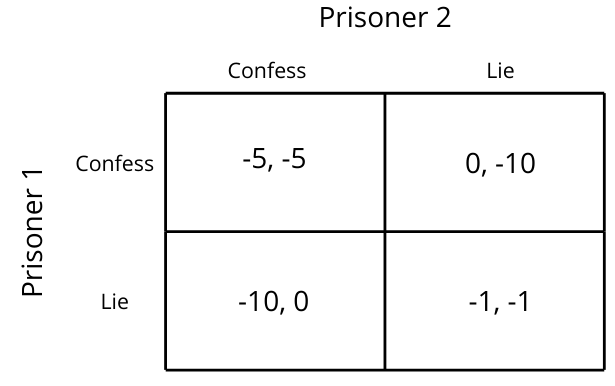Game Theory: Definition & Examples
What is Game Theory
Game theory is the study of strategic decision making between individuals. Although termed ‘game theory’, it refers to any interaction between multiple people where each person’s pay off is affected by the decision made by others. It is commonly applied within many social sciences, as well as systems science, war, politics, psychology, and computer science.
With regards to economics, game theory looks at how and why individuals make decisions, how those decisions impact on others choices, and how the result may, in fact, be undesirable to all parties involved. For example, there are three stores that sell televisions. All three stores charge a price of $300 per unit. However, when one store lowers the price, game theory looks at how the other stores would react to this. More often than not, those stores would also reduce their prices.
Key Points
- Game theory is only applicable when there are two or more participants who can affect the decisions of others.
- The actions and decisions of each player affect the outcome of each.
- In game theory, it is assumed that each player is rational and wants to maximize their utility.
Game theory can be seen as a game of chess, but in real life involving real people and real economic decisions. One individual makes a move and game theory would look at what would a rational individual do in response. For example, the government may offer a $10 million subsidy to farmers to product more corn. Game theory may suggest that those farmers would respond rationally by producing more corn.
However, not all individuals make rational decisions – which is why game theory cannot always identify the correct outcome. Yet it can help identify the potential outcomes. Game theory helps conceptualize potential outcomes from other individuals’ decisions and how one person’s decision can then impact on their decision.
This can turn into an endless loop whereby each individual is making a decision based on the perceived response from the other. It can be seen as a game of chess whereby one player is moving a piece in anticipation that the opposite player will make a specific move.
For instance, a player may sacrifice a pawn in order to save their knight and the opposite player may do so in the knowledge that they will make that move. Yet there are many possible outcomes that both players may take, which can make game theory incredibly complex.
In business, game theory helps model different outcomes and behaviors between firms. Each business has different strategic options that are dependent on the decisions of others. For example, Apple may not want to invest in advertising and marketing but are forced to do so because Samsung does – else Samsung will gain the upper hand. Yet both parties may be unwilling to advertise, but do so in the fear that the other will and therefore gain the upper hand.
Game Theory Conditions
In game theory, there are a number of conditions that need to be met in order for it to be considered a ‘game’ for the purposes of modelling. They are:
- Two or more choices: each player must have multiple options to choose from.
- All possible combinations result in an outcome: each player is aware of what their actions may result in.
- It is clear how participants can win or lose: in chess, the objective is clear – to take the king. In business, the objective is simply to make the most money.
- Know the rules of the game and the payoffs of other players: each player knows the constraints within the game. For example, businesses know they cannot bribe officials and chess players know that the bishop can only move diagonally.
- Players are rational and sensible: it is assumed that players will operate in their own self-interest. For instance, a business would not deliberately sell its assets at a huge loss.
- Non-cooperative: players do not collude with each other. For instance, in the game of monopoly, it could be easy for two players to collude to buy the necessary properties and dump other players out of the game.
These are the necessary conditions in order for a situation to be considered under game theory. Without two or more players, there is no game. It is only when there are two or more players that present each player with the uncertainty of the other’s decision. This is only applicable when both players cannot co-operate and therefore do not know what the other is going to do – which often leads to sub-optimal results.
Game theory takes these conditions and looks at how individuals respond under them. By doing so, it becomes apparent that individuals do not necessarily work in their own self-interest, but work based on the view of what the other player will do. For instance, in the game of chess, some players may look to sacrifice a piece under the assumption that the opposition will take that piece and therefore open an opportunity elsewhere.
There is also the issue of imperfect information. Game theory is not applicable to such situations as players cannot make rational and informed decisions. For example, there is a large element of luck in the game of poker. Whilst there is also a large element of skill as players bluff and counter-bluff, there is no way by which a player can lose with a good hand. Players cannot rationally act when faced with uncertainty. Whereas in the game of chess, each player knows the game and the potential moves the other can make. Therefore the actions a player takes can be more predictable.
Game Theory Examples
Game theory is applicable to a number of different scenarios, ranging from zero and non-zero sum games, to symmetric/asymmetric, to simultaneous/sequential. This have many applications ranging from war, to politics, to economic decision making. Some examples include:
The Prisoner’s Dilemma
The prisoner’s dilemma is perhaps the most commonly cited example of game theory. It looks at two criminals who have been arrested for a crime, but prosecutors have little evidence to convict them. As a result, they try to gain a confession from each by confining each prisoner to their cell. This removes the ability for both parties to co-operate with each other. The prisoners are then given four options.

- If both confess, they receive a five-year prison sentence.
- Prisoner 1 confesses, but Prisoner 2 lies, meaning Prisoner 1 gets off free, whilst Prisoner 2 gets 10 years.
- Prisoner 2 confesses, but Prisoner 1 lies, meaning they get off free, whilst Prisoner 1 gets 10 years.
- If neither confess, each will only serve one year in prison.
The most optimal strategy for both parties is to both lie and only take a year in prison each. Yet, because they are unable to co-operate, they may believe that the other is willing to confess in order to go free. After all, that would be the most optimal outcome for the individual rather than the whole. This leads us to what is known as the Nash equilibrium.
Both players will make the decision that favours them, but is in fact the worst outcome for them collectively. With regards to the prisoner’s dilemma, this would be for both Prisoners to confess and take 5 years in prison. This is superior to 10 years, but inferior to going free.
However, this is often the chosen option because Prisoner 2 believes that Prisoner 1 will work in their self-interest and confess to getting off free. At the same time, Prisoner 1 believes the same as Prisoner 2. So both working on the belief that the opposite party is working in their self-interest, they both confess – resulting in a sub-optimal outcome for the group.
Volunteer’s Dilemma
The volunteers dilemma is where an individual has to undertake a course of action which benefits the common good. The worst outcome occurs when nobody volunteers. For example, one student in the class is cheating, though some of the other students are aware of it.
If one of the students make the teachers aware, they may become ostracised from the other students as they are a ‘snitch’. Yet if they do nothing, then it becomes normal to cheat and therefore diminishes the achievement of those who did not.

Photo by Roman Synkevych on Unsplash
This social phenomena is also known as the bystander effect. For another example, consider someone having a fight in the street. Hundreds of people may walk past, but none take action to diffuse the situation. The consequence of intervening may be to get hurt themselves, but the alternative is for someone to seriously get hurt. Some will inevitably leave it in the thought that someone else will handle the situation.
Spanish invasion of Mexico
During the Spanish invasion of Mexico in 1519, the Spanish conqueror, Cortes, landed with a small force which was far outnumbered by the Mexican Aztec army. Acknowledging the Aztecs advantage, the Spanish leader, Cortes, burnt down all their ships with the intention of motivating his soldiers.
This leads into game theory as the soldiers had two options – fight or run away. Should the soldiers decide to fight, they risk losing their life against the numerous Aztecs, but should they fight and win, they share in the glory. However, it’s a more safer bet if they were to run away due to the Aztecs superior numbers.
By burning down the ships, Cortes removes the most likely option his soldiers would choose in those circumstances. So the soldiers must stay, and because their only way out is removed, they become even more motivated to fight for the cause. At the same time, this action discouraged the motivation of the Aztecs.
This is because by burning his own ships, the Aztecs believed that only a confident commander would do such a thing. After all, any commander who would burn his own ships would only do such if they were sure of victory. In a way, it is pokers equivalent of going ‘all in’. What resulted is the Aztecs retreated into the surrounding hills and Cortes gained an almighty victory.
Game Theory and Oligopoly
Game theory is frequently applied to oligopolies whereby there are only a few suppliers in the market. All are highly dependent on each other and the decision of one can have a dramatic impact on the choices of the other.
For example, the games console battle between PlayStation, and Xbox shows how interdependent some markets can be. If one lowers the price of its consoles, it may gain significant demand over the other – although its profit margins will decline. If PlayStation were to keep prices the same, then profit margins would remain strong. However, they are relying on Xbox to also do the same. For if Xbox was to reduce its prices, then PlayStation may lose customers and profits.
This leads onto the potential for collusion in such circumstances. If Xbox reduces its prices, then PlayStation will be encouraged to do the same else lose customers. The result is that both end up with lower profits and profit margins. Instead, it would make more sense for them to collude and ensure they both keep prices high. This opens up the issue of whether oligopolies do in fact participate in such collusion – as it would logically benefit both parties.
FAQs
Game theory studies the interaction and potential outcomes between individuals – highlighting the need for cooperation to achieve the most optimal outcomes for both parties.
Game theory is important because it allows competitors to determine alternative solutions which can lead to the most optimal outcome.
Game theory was originally coined by John von Neumann in order to solve economic issues – particularly the incomplete work of Adam Smith which stated that individuals following their own self-interest will benefit society as a whole. Instead, game theory shows that whilst this may be the case, society benefits when individuals come together and cooperate.
About Paul
Paul Boyce is an economics editor with over 10 years experience in the industry. Currently working as a consultant within the financial services sector, Paul is the CEO and chief editor of BoyceWire. He has written publications for FEE, the Mises Institute, and many others.

Further Reading
 Utility Maximization: Definition, Example & Limitations - Table of Contents What is Utility Maximization Utility Maximization Rule Utility Maximization Example Limitations of Utility Maximisation Utility Maximization FAQs…
Utility Maximization: Definition, Example & Limitations - Table of Contents What is Utility Maximization Utility Maximization Rule Utility Maximization Example Limitations of Utility Maximisation Utility Maximization FAQs…  New York City Minimum Wage: The minimum wages impact on jobs - The situation looks dire for full-service restaurant workers. Since the increase to $13, the number of workers declined by over…
New York City Minimum Wage: The minimum wages impact on jobs - The situation looks dire for full-service restaurant workers. Since the increase to $13, the number of workers declined by over…  Constant Returns to Scale - Constant Returns to Scale (CRS) refers to a production or cost structure where increasing all inputs by a certain proportion…
Constant Returns to Scale - Constant Returns to Scale (CRS) refers to a production or cost structure where increasing all inputs by a certain proportion… 